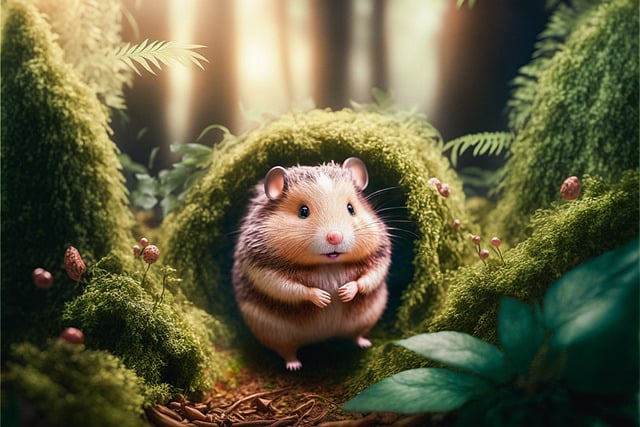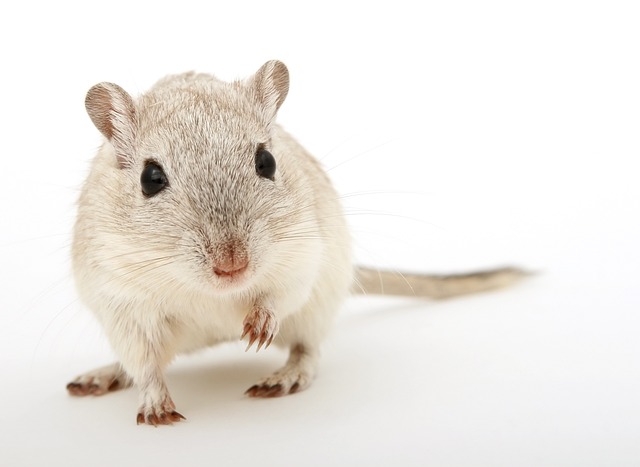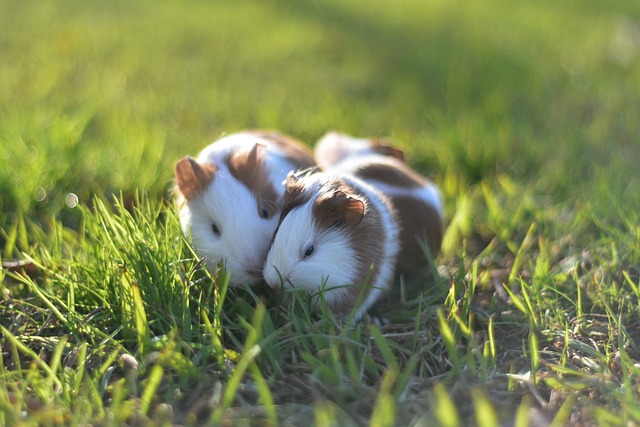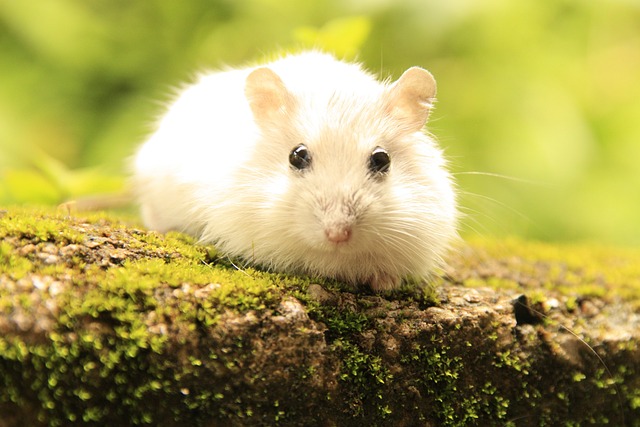Can Hamsters Climb Tree And Wall – Hamsters.pk
The Natural Climbing Abilities of Hamsters
Hamsters are adorable and lively pets known for their playful nature and cute appearance. While these small rodents are often seen scurrying around their cages or exploring their surroundings, many pet owners wonder about their climbing abilities. In this article, we’ll delve into the natural climbing skills of hamsters and explore how these abilities vary among different species.
Hamsters in the Wild
In their natural habitats, hamsters are ground-dwelling animals that live in burrows and tunnels. They are not typically known for their climbing prowess, as they spend most of their time foraging for food and building intricate underground homes. However, some wild hamster species, such as the European hamster (Cricetus cricetus), have been observed climbing small shrubs and plants to gather food.
Climbing Abilities of Pet Hamsters
When it comes to pet hamsters, their climbing abilities can vary depending on the species and individual personality. Here are some common pet hamster species and their climbing tendencies:
- Syrian Hamsters (Mesocricetus auratus): Also known as Golden hamsters, these are the largest and most popular pet hamster species. While they are not exceptional climbers, they can navigate simple obstacles and climb low-height objects in their cages.
- Dwarf Hamsters: This category includes several smaller hamster species, such as Campbell’s dwarf hamsters (Phodopus campbelli), Winter White dwarf hamsters (Phodopus sungorus), and Roborovski dwarf hamsters (Phodopus roborovskii). These agile little hamsters are generally better climbers than their larger Syrian counterparts. They can often be seen scaling cage bars and exploring vertical spaces.
- Chinese Hamsters (Cricetulus griseus): Although not technically true hamsters, these small, mouse-like rodents are often kept as pets. Chinese hamsters are known for their excellent climbing skills and can easily navigate complex cage setups with multiple levels and obstacles.
Factors Affecting Hamster Climbing Abilities
Several factors can influence a hamster’s climbing abilities, including:
- Age: Young hamsters are typically more agile and curious, making them more likely to explore and attempt climbing. As hamsters age, their climbing abilities may decline due to reduced energy levels and potential health issues.
- Health: A hamster’s overall health can impact its climbing skills. Hamsters with injuries, obesity, or age-related conditions may find it more challenging to climb and navigate vertical spaces.
- Cage Setup: The design and layout of a hamster’s cage can either encourage or discourage climbing behavior. Cages with multiple levels, ramps, and climbing accessories provide opportunities for hamsters to exercise their natural climbing instincts.
Keeping Your Hamster Safe
While climbing can be a natural and enjoyable activity for hamsters, it’s essential to ensure their safety. Here are some tips to keep your hamster safe during climbing adventures:
- Provide a secure and escape-proof cage with no gaps or openings that your hamster could squeeze through while climbing.
- Avoid using tall or unstable objects in the cage that could topple over and injure your hamster.
- Supervise your hamster during playtime outside the cage to prevent falls and accidents.
- Offer a soft landing surface, such as a cushion or blanket, when allowing your hamster to explore and climb outside the cage.
In conclusion, hamsters have varying climbing abilities depending on their species and individual characteristics. While they may not be expert climbers like some other small pets, most hamsters can still enjoy exploring vertical spaces and navigating obstacles in their cages. By providing a safe and stimulating environment, you can encourage your hamster’s natural climbing instincts while ensuring their well-being.
Exploring the Limitations of Hamster Climbing Skills

While hamsters are known for their playful and adventurous nature, their climbing abilities are not without limitations. As small, ground-dwelling rodents, hamsters have certain physical and behavioral characteristics that can restrict their climbing skills. In this article, we’ll explore the various factors that limit hamsters’ climbing abilities and discuss how pet owners can create a safe and suitable environment for their furry friends.
Anatomical Limitations
One of the primary factors limiting hamsters’ climbing skills is their anatomy. Here are some anatomical features that can impact their climbing abilities:
- Body Size and Shape: Hamsters have compact, rounded bodies that are not ideally suited for climbing. Their center of gravity is relatively high, which can make it challenging to maintain balance on narrow or vertical surfaces.
- Short Legs: Compared to other small pets, such as mice or rats, hamsters have shorter legs in proportion to their body size. This can limit their reach and make it more difficult to navigate complex climbing structures.
- Lack of Specialized Climbing Adaptations: Unlike some other small mammals, such as squirrels or certain species of mice, hamsters do not have specialized anatomical adaptations for climbing, such as sharp claws or prehensile tails.
Behavioral Limitations
In addition to anatomical limitations, hamsters’ natural behaviors and instincts can also influence their climbing abilities:
- Ground-Dwelling Nature: In the wild, hamsters are primarily ground-dwelling animals that live in burrows and tunnels. They are adapted to a terrestrial lifestyle and may not have a strong instinctual drive to climb.
- Cautiousness and Fear of Heights: Some hamsters may be naturally cautious or fearful of heights, which can discourage them from attempting to climb tall objects or explore elevated areas.
- Individual Personality: Just like humans, hamsters have unique personalities. Some hamsters may be more adventurous and curious, while others may prefer to stay on solid ground. These individual traits can impact a hamster’s willingness to climb and explore.
Environmental Factors
The environment in which a hamster lives can also play a role in their climbing behavior and abilities:
- Cage Setup: The design and layout of a hamster’s cage can either encourage or discourage climbing. Cages with tall, smooth walls or lack of climbing accessories may not provide adequate opportunities for hamsters to practice and develop their climbing skills.
- Lack of Stimulation: A cage that lacks variety and stimulation may not motivate a hamster to explore and climb. Providing a range of toys, tunnels, and climbing structures can help keep hamsters mentally and physically engaged.
- Injury or Health Issues: Hamsters with injuries, disabilities, or age-related health problems may find it more challenging or painful to climb, limiting their ability to navigate vertical spaces.
Creating a Safe Climbing Environment
Despite their limitations, many hamsters still enjoy climbing and exploring their surroundings. As a pet owner, you can create a safe and enriching environment that allows your hamster to engage in climbing activities while minimizing risks:
- Provide a Secure and Escape-Proof Cage: Ensure that your hamster’s cage has no gaps or openings that they could squeeze through while climbing, preventing escapes and potential injuries.
- Offer Suitable Climbing Accessories: Include hamster-safe climbing toys, such as ladders, ramps, and low-height platforms, to encourage supervised climbing within your hamster’s abilities.
- Avoid Tall or Unstable Objects: Refrain from placing tall, unstable objects in the cage that could topple over and injure your hamster.
- Supervise Playtime: When allowing your hamster to explore and climb outside the cage, always supervise them closely to prevent falls and accidents.
In conclusion, while hamsters possess some natural climbing abilities, they are not without limitations. Their anatomy, behavior, and environment can all impact their climbing skills. By understanding these limitations and providing a safe, enriching habitat, pet owners can ensure that their hamsters can engage in climbing activities while minimizing potential risks.
Keeping Your Hamster Safe: Preventing Climbing Accidents
As a responsible pet owner, ensuring your hamster’s safety is of utmost importance. While hamsters are naturally curious and enjoy exploring their surroundings, their climbing adventures can sometimes lead to accidents. In this article, we’ll discuss the potential risks associated with hamster climbing and provide practical tips on preventing accidents and keeping your furry friend safe.
Understanding the Risks
Hamsters are small and fragile creatures, and even a short fall can cause serious injuries. Here are some of the risks associated with hamster climbing accidents:
- Broken Bones: A fall from a significant height can result in broken bones, particularly in a hamster’s delicate limbs or spine.
- Internal Injuries: The impact of a fall can cause internal injuries, such as organ damage or internal bleeding, which may not be immediately visible.
- Concussions: A blow to the head from a fall can lead to a concussion, which can cause disorientation, loss of balance, and other neurological symptoms.
- Sprains and Strains: Awkward landings or falls can result in sprains or strains in a hamster’s muscles, tendons, or ligaments.
Providing a Safe Cage Environment
The first step in preventing climbing accidents is to create a safe and secure cage environment for your hamster:
- Choose an Appropriate Cage Size: Ensure that your hamster’s cage is large enough to accommodate their activity levels and climbing needs. A cage that is too small can lead to frustration and attempts to escape through climbing.
- Secure the Cage: Check that the cage is properly assembled and that there are no gaps or loose parts that your hamster could exploit to escape while climbing.
- Avoid Tall Structures: Refrain from including excessively tall structures or objects in the cage that could pose a falling hazard. Stick to low-height platforms and climbing accessories that are specifically designed for hamsters.
- Provide Soft Bedding: Use a layer of soft, absorbent bedding material to cushion any potential falls and minimize the risk of injuries.
Supervising Playtime
When allowing your hamster to explore and climb outside the cage, it’s crucial to provide close supervision:
- Create a Safe Play Area: Set up a designated, hamster-proofed play area that is free from hazards such as electrical cords, steep drops, or small spaces where your hamster could get stuck.
- Use a Playpen: Consider using a secure playpen or exercise ball to contain your hamster’s exploration and prevent them from accessing dangerous areas.
- Keep an Eye on Your Hamster: Always supervise your hamster closely during playtime, and never leave them unattended in an unsecured area.
- Provide Soft Landing Spots: Place cushions, blankets, or other soft materials around the play area to provide a safer landing surface in case of falls.
Recognizing Signs of Injury
Even with precautions in place, accidents can still happen. It’s essential to be aware of the signs that may indicate your hamster has been injured from a climbing incident:
- Limping or Favoring a Limb: If your hamster is limping or favoring one limb over the others, it may have suffered a sprain, strain, or fracture.
- Lethargy or Decreased Activity: A hamster that is unusually lethargic or inactive may be experiencing pain or discomfort from an injury.
- Changes in Behavior: Unusual aggression, hiding, or changes in eating or grooming habits can all be signs of an underlying injury or pain.
If you suspect your hamster has been injured, it’s crucial to seek veterinary care promptly. A veterinarian specializing in small animals can properly diagnose and treat any injuries or complications resulting from a climbing accident.
In conclusion, preventing climbing accidents is an essential aspect of responsible hamster care. By providing a safe cage environment, supervising playtime, and being aware of potential signs of injury, you can help keep your hamster safe and healthy while allowing them to explore and enjoy their natural climbing instincts.
Providing a Stimulating Environment for Your Hamster Without Climbing Risks
Creating a stimulating and enriching environment for your hamster is essential for their physical and mental well-being. However, it’s equally important to ensure that this environment is safe and minimizes the risks associated with climbing accidents. In this article, we’ll explore various ways to provide your hamster with a stimulating habitat while keeping them safe from climbing-related injuries.
Understanding Your Hamster’s Needs
Before designing your hamster’s environment, it’s crucial to understand their natural behaviors and needs:
- Burrowing: Hamsters are natural burrowers and require a deep layer of bedding material to satisfy their digging instincts.
- Foraging: In the wild, hamsters spend a significant amount of time foraging for food. Providing opportunities for foraging can keep your hamster mentally stimulated.
- Exercise: Hamsters are active creatures and need ample space and opportunities for exercise to maintain their physical health.
- Exploration: Curious by nature, hamsters enjoy exploring their surroundings and discovering new experiences.
Creating a Safe and Stimulating Cage Layout
When designing your hamster’s cage, focus on creating a safe and stimulating layout that encourages natural behaviors without the need for risky climbing structures:
- Provide a Spacious Cage: Choose a cage that offers ample floor space for your hamster to run, play, and explore. A larger cage allows for more enrichment opportunities without relying on vertical space.
- Include Tunnels and Hideouts: Incorporate hamster-safe tunnels, tubes, and hideouts into the cage layout. These elements satisfy your hamster’s natural burrowing instincts and provide a sense of security.
- Offer Burrowing Opportunities: Fill the cage with a deep layer of safe, non-toxic bedding material, such as paper-based bedding or aspen wood shavings. This allows your hamster to dig, burrow, and create tunnels.
- Use Low-Height Platforms: If you want to include platforms or levels in the cage, opt for low-height options that minimize the risk of falls. Ensure that these platforms are sturdy and securely attached to the cage walls.
Providing Mental Stimulation and Exercise
In addition to a safe cage layout, there are various ways to provide mental stimulation and exercise for your hamster without relying on climbing structures:
- Offer Foraging Toys: Scatter your hamster’s food or hide it in foraging toys, such as puzzle feeders or treat balls. This encourages your hamster to use their natural foraging instincts and provides mental stimulation.
- Include Chew Toys: Hamsters have a natural need to chew to keep their continuously growing teeth in check. Provide a variety of hamster-safe chew toys, such as wooden blocks, willow balls, or hay-based chews.
- Introduce Wheel and Ball: A solid-surface exercise wheel or a hamster ball allows your hamster to engage in physical activity without the need for climbing. Ensure that the wheel or ball is appropriately sized for your hamster and is used under supervision.
- Create Obstacle Courses: Set up low-height obstacle courses using hamster-safe toys, tunnels, and hideouts. This provides mental stimulation and encourages exploration without the risk of high falls.
Supervised Playtime Outside the Cage
To further enrich your hamster’s environment, consider offering supervised playtime outside the cage:
- Set Up a Safe Play Area: Create a designated, hamster-proofed play area that is free from hazards and escape routes. Ensure that the area is enclosed and supervised at all times.
- Provide Interesting Toys: Introduce new toys, tunnels, and hiding spots in the play area to keep your hamster engaged and mentally stimulated.
- Facilitate Interaction: Use playtime as an opportunity to bond with your hamster through gentle handling and interaction. This provides social enrichment and strengthens the bond between you and your pet.
In conclusion, providing a stimulating environment for your hamster doesn’t have to involve risky climbing structures. By focusing on a safe cage layout, offering mental stimulation and exercise opportunities, and facilitating supervised playtime, you can create an enriching habitat that meets your hamster’s needs while minimizing the risk of climbing accidents.












